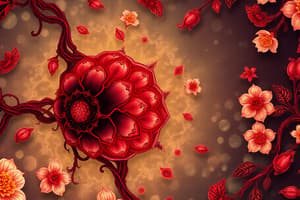Podcast
Questions and Answers
What is the primary function of the liquid portion of blood, which makes up approximately 55% of total blood volume?
What is the primary function of the liquid portion of blood, which makes up approximately 55% of total blood volume?
- Production of red blood cells
- Regulation of body temperature
- Transportation of nutrients and waste (correct)
- Transport of oxygen
In a centrifuged blood sample, what constitutes the middle layer that is described as a thin gray-white color?
In a centrifuged blood sample, what constitutes the middle layer that is described as a thin gray-white color?
- Clotted blood cells
- Plasma containing proteins
- Erythrocytes or red blood cells
- Platelets and white blood cells (correct)
What percentage of the sediment portion of blood is made up of erythrocytes after centrifugation?
What percentage of the sediment portion of blood is made up of erythrocytes after centrifugation?
- About 30%
- About 60%
- Approximately 44% (correct)
- Approximately 50%
When blood is centrifuged, what color is the plasma that separates into the upper layer?
When blood is centrifuged, what color is the plasma that separates into the upper layer?
Which component is primarily responsible for the red color seen in the sediment portion of the blood after centrifugation?
Which component is primarily responsible for the red color seen in the sediment portion of the blood after centrifugation?
What is the average blood volume in a normal adult male?
What is the average blood volume in a normal adult male?
Which component of blood gives it its bright red color?
Which component of blood gives it its bright red color?
At what stage of development does hematopoiesis primarily occur in the red bone marrow?
At what stage of development does hematopoiesis primarily occur in the red bone marrow?
How does the pH level of blood generally compare to neutrality?
How does the pH level of blood generally compare to neutrality?
Which of the following sites is NOT involved in blood cell formation during early development?
Which of the following sites is NOT involved in blood cell formation during early development?
Which statement about venous blood is correct?
Which statement about venous blood is correct?
What is the primary reason blood is considered a connective tissue?
What is the primary reason blood is considered a connective tissue?
What is the average temperature of blood in the human body?
What is the average temperature of blood in the human body?
Flashcards
Plasma
Plasma
The liquid portion of blood, making up about 55% of its volume.
Formed Elements
Formed Elements
The solid portion of blood, composed of red blood cells, white blood cells, and platelets. They make up about 45% of blood volume.
Erythrocytes
Erythrocytes
Red blood cells, also known as erythrocytes, are the most abundant formed element. They are responsible for carrying oxygen throughout the body.
Centrifugation
Centrifugation
Signup and view all the flashcards
Hematocrit
Hematocrit
Signup and view all the flashcards
Hematopoiesis
Hematopoiesis
Signup and view all the flashcards
Blood
Blood
Signup and view all the flashcards
Yolk sac
Yolk sac
Signup and view all the flashcards
Sites of Hematopoiesis
Sites of Hematopoiesis
Signup and view all the flashcards
Blood Color
Blood Color
Signup and view all the flashcards
Blood Viscosity
Blood Viscosity
Signup and view all the flashcards
Blood Volume
Blood Volume
Signup and view all the flashcards
Study Notes
Blood Overview
- Blood is a fluid connective tissue that circulates throughout the body within blood vessels.
- It flows in a unidirectional manner.
- It is composed of liquid (plasma) and solid components (blood cells).
- In medical terms, blood is also referred to as hemo or hemato.
Blood Properties
- Color: Arterial blood is bright red (high oxygen) and venous blood is dark purple/red (low oxygen).
- Volume: Average adult male blood volume is 5-6 liters, and for females is 4-5 liters. A newborn's blood volume is approximately 450 ml.
- Weight: Blood comprises about 8% of the total body weight in a healthy adult.
- Reaction and pH: Blood is slightly alkaline, with a pH of 7.4 under normal conditions.
- Viscosity: Blood is approximately five times more viscous than water due to red blood cells and plasma proteins.
- Temperature: Blood temperature is about 38°C, 1°C higher than normal body temperature.
Blood Formation
- Early Embryonic Development: Blood formation initially occurs in the yolk sac; later, the liver, spleen, and lymph nodes become involved.
- Adult: Hematopoiesis mainly takes place in the red bone marrow.
Blood Composition & Components
- Plasma (Liquid Portion): Approximately 55% of whole blood, it is a straw-colored liquid.
- Primarily water, with proteins (albumins, globulins, fibrinogen), electrolytes, nutrients, respiratory gases, and waste products.
- Formed Elements (Solid Portion): Approximately 45% of whole blood.
-
Erythrocytes (Red Blood Cells): 3.5-5.5 million/mm³, red-colored, biconcave discs, crucial for oxygen transport.
-
Leukocytes (White Blood Cells): ~4500-11,000/mm³, colorless, crucial in immune response and defense against infection.
- Granulocytes (contain granules): Neutrophils, Eosinophils, Basophils.
- Agranulocytes (lack granules): Lymphocytes, Monocytes.
-
Platelets (Thrombocytes): ~150,000-400,000/mm³, cell fragments involved in blood clotting and preventing blood loss.
-
Blood Functions
- Transport of gases, nutrients, hormones, and waste products.
- Regulation of body temperature.
- Maintenance of body pH and fluid balance (osmosis).
- Protection against infections and diseases.
- Blood clotting (hemostasis).
Abnormal Blood Cell Counts
- Pena: Decrease in cell numbers.
- Cytosis: Increase in cell numbers.
Studying That Suits You
Use AI to generate personalized quizzes and flashcards to suit your learning preferences.




